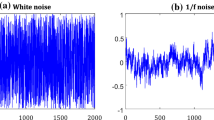Abstract
The recently introduced multivariate multiscale sample entropy (MMSE) well evaluates the long correlations in multiple channels, so that it can reveal the complexity of multivariate biological signals. The existing MMSE algorithm deals with short time series statically whereas long time series are common for real-time computation in practical use. As a solution, we novelly proposed our dynamic MMSE (DMMSE) as an extension of MMSE. This helps us gain greater insight into the complexity of each section of time series, producing multifaceted and more robust estimates than the standard MMSE. The simulation results illustrated the feasibility and well performance in the brain death diagnosis.
Similar content being viewed by others
References
Cao J T, Chen Z. ICA and complexity measures of EEG analysis in brain death determination. Advances in Cognitive Neurodynamics ICCN 2007. Berlin: Springer, 2008. 699–703
Chen Z, Cao J T, Cao Y, et al. An empirical EEG analysis in brain death diagnosis for adults. Cogn Neurodynamics, 2008, 2: 257–271
Cao J T. Analysis of the quasi-brain-death EEG data based on a robust ICA approach. Knowledge-Based Intelligent Information and Engineering Systems. Berlin: Springer, 2006. 1240–1247
Shi Q W, Zhou W, Cao J T, et al. Brain-computer interface system using approximate entropy and EMD techniques. Advances in Swarm Intelligence. Berlin: Springer, 2010. 204–212
Cao J T, Chen Z. Advanced EEG signal processing in brain death diagnosis. Signal Processing Techniques for Knowledge Extraction and Information Fusion. Berlin: Springer, 2008. 275–297
Eelco F, Wijdicks M. Brain death worldwide. Neurology, 2002, 58: 20–25
Taylor R M. Reexaming the definition and criteria of death. Semin Neurol, 1997, 17: 265–270
Goshvarpour A, Goshvarpour A. Comparison of higher order spectra in heart rate signals during two techniques of meditation: Chi and kundalini meditation. Cogn Neurodynamic, 2013, 7: 39–46
Fehr T. A hybrid model for the neural representation of complex mental processing in the human brain. Cogn Neurodynamic, 2013, 7: 89–103
Pincus S M. Approximate entropy as a measure of system complexity. Proceedings of the National Academy of Sciences of the United State of America, 1991, 88: 2297–2301
Richman J S, Moorman J R. Physiological time-series analysis using approximate entropy and sample entropy. Am J Physiol-heart C, 2000, 278: 2039–2049
Costa M, Goldberger A L, Peng C K. Multiscale entropy analysis of complex physiologic time series. Phys Rev Lett, 2002, 89: 68–102
Hu M, Liang H L. Intrinsic mode entropy based on multivariate empirical mode decomposition and its application to neural data analysis. Cogn Neurodynamic, 2011, 5: 277–284
Hu M, Liang H L. Adaptive multiscale entropy analysis of multivariate neural data. IEEE T Biomed Eng, 2011, 59: 12–15
Ahmed M U, Li L, Cao J T, et al. Multivariate multiscale entropy for brain consciousness analysis. In: Engineering in Medicine and Biology Society, EMBC, 2011 Annual International Conference of the IEEE. Boston, 2011. 810–813
Yang K, Cao J T, Wang R B, et al. Analyzing EEG of quasi-brain-death based on dynamic approximate entropy measures. Chinese J Bio Eng, 2011, 30: 27–33
Cao L, Mees A, Judd K. Dynamic from multivariate time series. Physica D, 1998, 121: 75–88
Guatama T, Mandic D P, Van Hulle M M. The delay vector variance method for detecting determinism and nonlinearity in time series. Physica D, 2004, 190: 167–176
Li L, Saito Y, Looney D, et al. Data fusion via fission for the analysis of brain death. Evolving Intelligent Systems: Methodology and Applications. Berlin: Springer, 2010. 279–320
Ni L, Cao J, Wang R. Analyzing EEG of quasi-brain-death based on dynamic sample entropy measures. Comput Math Method M, 2013, 2013: 618743
Author information
Authors and Affiliations
Corresponding author
Rights and permissions
About this article
Cite this article
Ni, L., Cao, J. & Wang, R. Dynamic multivariate multiscale entropy based analysis on brain death diagnosis. Sci. China Technol. Sci. 58, 425–433 (2015). https://doi.org/10.1007/s11431-014-5757-0
Received:
Accepted:
Published:
Issue Date:
DOI: https://doi.org/10.1007/s11431-014-5757-0




